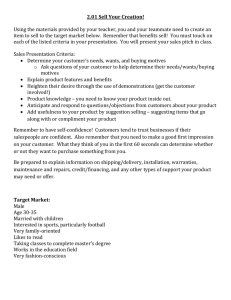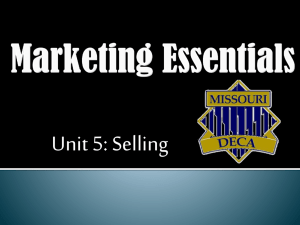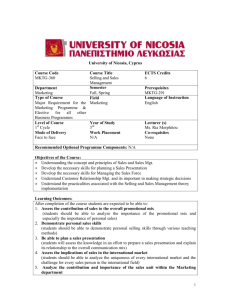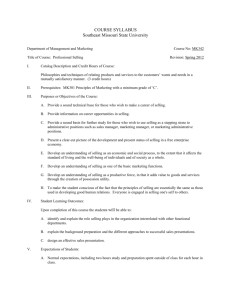Developing and Managing Sales
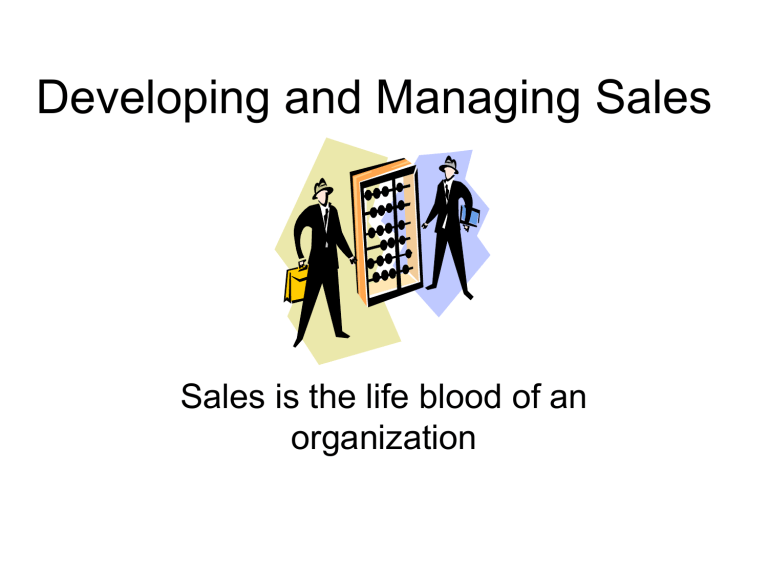
Developing and Managing Sales
Sales is the life blood of an organization
Sales Force Terms
Personal Selling Order getting
Order taking Rational buying Motives
Irrational Buying Motives Customer Benefits
Buying Process Prospecting
Selling Process Closing Techniques
Objections Suggestive Selling
Approach Presentation
Quota Call reports
Forecast Definition of a Sale
Commission Strait Salary
A Sale is
A solution to someone’s problem
Personal Selling
Is an oral presentation made by a salesperson to help the customer make a decision.
There is two types of salespeople
Order Takers and Order Getters
Order getting is also know as
“Creative Selling”
Order Getters seek out buyers and give organized thought-through presentations. Order Getters are highly desired by organizations and are often paid well for their sales skills.
In Contrast, Order Takers
Do little, but stand at a cash register and complete a sales transactions (Retail clerks).
Traits of a good sales person
Knowledgeable Organized
Punctual Energetic
Empathic Prompt
Able to solve problems Honest
Interpersonal Skills
The reason most people will buy from a salesperson is that they liked him or her.
Friendly, outgoing people make good salespeople.
Skills & Knowledge for Selling
Product Knowledge
Company Knowledge
Customer Knowledge
Interpersonal Skills
Product Knowledge is:
Knowing the benefits of the product from personal knowledge of having used the product. Also salespeople need to know the competitor’s products, their product’s benefits, as well as products’ shortcomings.
Company Knowledge
Sales people need to know the organizational policies, procedures, values and interests.
Customer Knowledge
Customers buy for rational and emotional
(irrational) motives (reasons). Every
Target Market (TM) for every product has different customer buying motives.
Rational Buying Motives could include:
Dependability Quality
Saves money Service
Comfort Saves Time
Safety
Emotional Buying Motives could include:
Social approval Power
Recognition Prestige
The Buying Process is:
Five Steps
1.
Realizing there is a problem
2.
Defining the problem
3.
Search for solutions to the problem
4.
Making the decision
5.
Evaluating the decision
Ten steps Selling Process
1. Prospecting: is looking for customers.
Cold canvassing is a form of prospecting.
Cold canvassing is making contact with a customer without sales leads.
2. Pre-approach
Research the customer, do a credit check or gather information about their needs.
3. Approach
This is the first contact with the customer and should make a good impression in order to gain the trust of the customer.
4. Determine the customer’s needs
Listen carefully and ask questions about wants and needs
5. Presentation
This could be a demonstration or just telling the customer what benefits your product offers
6. Overcoming Objections
Objections are customer reasons not to buy.
Good salespeople anticipates these and provide additional information about the product or service.
7. Closing the Sale
Closing refers to completing the sale and getting the customer to say “Yes”.
8. Suggestion Selling
Once apparent that the customer will buy, suggest additional items that complement the sale. “Would you like fries with that?”
9. Completing the sale
This is writing up the order or ringing up the sale.
10. Follow-up
A sale is not complete until the customer is satisfied. The goal of good salespeople is to establish long-term relationships for repeat sales.
When evaluating your sales people
Monitor the number of leads given to the sales person and determine how many sales were made from those leads (%).
When paying Salespeople
•
• They can be paid by Commission, % $ of amount sold.
Strait Salary is:
$ predetermined amount annually, monthly or weekly
Most Salespeople
Are paid by a combination of both salary and commission.
Call Reports
Have the salespeople create “Sales Call Reports”.
On these reports, how much time was spent with customers, miles traveled, days worked, new prospects and how likely those potential customers will buy should all be included.
Establish Quotas (goals) for each salesperson, from the Call Reports and Industry Analysis
Sales Forecasting and Sales
Budgeting also should be tied
To the Sales Call Reports. “Nobody knows what is selling unless they try to sell it.”
